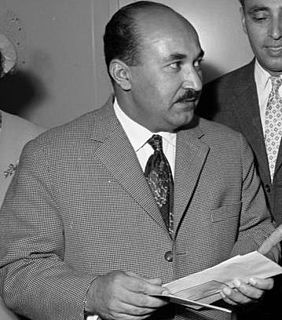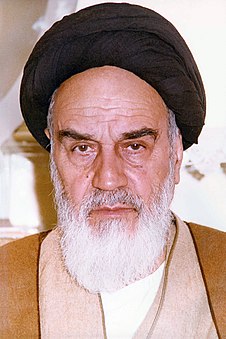
The Iranian Revolution was a series of events that involved the overthrow of the monarch of Iran, Mohammad Reza Shah Pahlavi, and the replacement of his government with an Islamic republic under the Grand Ayatollah Ruhollah Khomeini, a leader of one of the factions in the revolt. The movement against the United States-backed monarchy was supported by various leftist and Islamist organizations and student movements.

Sayyid Mohammad Kazem Shariatmadari, also spelled Shariat-Madari, was an Iranian Grand Ayatollah. He favoured the traditional Shiite practice of keeping clerics away from governmental positions and was a critic of Supreme Leader Ruhollah Khomeini, denouncing the taking hostage of diplomats at the US embassy in Tehran. In 1982 he was accused of being part of a plot to bomb Khomeini's home and to overthrow the Islamic state, and he remained under house arrest until his death in 1986. His followers also opposed Ruhollah Khomeini.

The demonstrations of June 5 and 6, also called the events of June 1963 or the 15 Khordad uprising, were protests in Iran against the arrest of Ayatollah Ruhollah Khomeini after his denouncement of Iranian Shah Mohammad Reza Pahlavi and Israel. The Shah's regime was taken by surprise by the massive public demonstrations of support, and although these were crushed within days by the police and military, the events established the importance and power of (Shia) religious opposition to the Shah, and Khomeini as a major political and religious leader. Fifteen years later, Khomeini was to lead the Iranian Revolution which overthrew the Shah and his Pahlavi dynasty and established the Islamic Republic of Iran.

A referendum on creating an Islamic Republic was held in Iran on 30 and 31 March 1979.

Mohammad Ali Araki was an Iranian Twelver Shia Marja'. Araki was teacher of many Iranian revolutionary person and was the last survivor from Ruhollah Khomeini's era. When he died, IRNA declared that "he was considered the greatest living Marja'".

This article is a timeline of events relevant to the Islamic Revolution in Iran. For earlier events refer to Pahlavi dynasty and for later ones refer to History of the Islamic Republic of Iran. This article doesn't include the reasons of the events and further information is available in Islamic revolution of Iran.

Many organizations, parties and guerrilla groups were involved in the Iranian Revolution. Some were part of Ayatollah Khomeini's network and supported the theocratic Islamic Republic movement, while others did not and were suppressed. Some groups were created after the fall of the Pahlavi Dynasty and still survive; others helped overthrow the Shah but no longer exist.
A number of observers, including the Shah, have written of rumours and allegations that the government of the United Kingdom has secretly supported "mullahs" in recent Iranian history, and in particular the Ayatollah Ruhollah Khomeini in his successful overthrow of Shah Mohammad Reza Pahlavi in the Iranian Revolution of 1979. It is alleged that the 1979 Iranian revolution is a Western response to the Pahlavi's White revolution which was intended to bring benefits to Iran and its people, but was unfavorable to the landlords, clergy and the United States and UK that feared that Iran will become independent, thus hampering their further involvement and control of Iranian petroleum. Khomeini rejected the charges, claiming it was the Shah who was a Western "agent" who had prevented the establishment of Islamic government in Iran until the revolution.
The National Democratic Front was a liberal-left political party founded during the Iranian Revolution of 1979 that overthrew shah Mohammad Reza Pahlavi, and banned within a short time by the Islamic government. It was founded by Hedayatollah Matin-Daftari, a grandson of celebrated Iranian nationalist Mohammad Mosaddeq and a "lawyer who had been active in human rights causes" before the downfall of the shah and the son of the fourth prime minister and the jurist Ahmad Matin-Daftari. Though it was short-lived, the party has been described as one of "the three major movements of the political center" in Iran at that time, and its ouster was one of the first indications that the Islamist revolutionaries in control of the Iranian Revolution would not tolerate liberal political forces.
The consolidation of the Iranian Revolution refers to a turbulent process of Islamic Republic stabilization, following the completion of the revolution. After the Shah of Iran and his regime were overthrown by revolutionaries in February 1979, Iran was in a "revolutionary crisis mode" from this time until 1982 or 1983. Its economy and the apparatus of government collapsed. Military and security forces were in disarray.
The Imperial state of Iran, the government of Iran during the Pahlavi dynasty, lasted from 1925 to 1979. During that time two monarchs — Reza Shah Pahlavi and his son Mohammad Reza Shah Pahlavi — employed secret police, torture, and executions to stifle political dissent. The Pahlavi dynasty has sometimes been described as a "royal dictatorship", or "one man rule". According to one history of the use of torture by the state in Iran, abuse of prisoners varied at times during the Pahlavi reign.

The Interim Government of Iran, officially the Provisional Revolutionary and Islamic Government of Iran was the first government established in Iran after the Iranian Revolution, and the first nominal republic established in Iran after 2,500 years of Persian monarchy. The regime was headed by Mehdi Bazargan, one of the members of the Freedom Movement of Iran, and formed on the order of Ruhollah Khomeini on 4 February 1979. From 4 February to 11 February, Bazargan and Shapour Bakhtiar, the Shah's last Prime Minister, both claimed to be the legitimate prime minister; Bakhtiar fled on 11 February. Mehdi Bazargan was the prime minister of the interim government and introduced a seven-member cabinet on 14 February 1979. Ebrahim Yazdi was elected as the Foreign Minister.
A referendum on the dissolution of Parliament, the first referendum ever held in Iran, was held in August 1953. The dissolution was approved by more than 99% of voters.
A constitutional referendum was held in Iran on 2 and 3 December 1979. The new Islamic constitution was approved by 99.5% of voters, with a 71.6% turnout.
Ahmad Khonsari, also Aḥmad Khvānsārī, or Khvunsārī was an Iranian Grand Ayatollah and attained marja status after the death of marja Boroujerdi in 1961. In contrast to the other maraji of his time, who lived in the holy cities of Qom or Najaf, he was based in Tehran, where he ran his own hawza. Khonsari was one of the teachers of Ayatollah Khomeini.

Sayyid Ruhollah Mūsavi Khomeini, known in the Western world as Ayatollah Khomeini, was an Iranian Shia Muslim religious leader, philosopher, revolutionary and politician. He was the founder of the Islamic Republic of Iran and the leader of the 1979 Iranian Revolution that saw the overthrow of the Pahlavi monarchy and Mohammad Reza Pahlavi, the Shah of Iran. Following the revolution, Khomeini became the country's Supreme Leader, a position created in the constitution of the Islamic Republic as the highest-ranking political and religious authority of the nation, which he held until his death. On 1 February 1979 Ayatollah Ruhollah Khomeini, returned to Iran after 14 years in political exile. Khomeini had been a prominent opponent of Mohammad Reza Shah Pahlavi, who had fled the country during the events of the Iranian Revolution. Upon his return, he was greeted by crowds of millions, and within 10 days the revolution would be successful. Khomeini's return and the 10 days following are now celebrated in Iran as the Fajr decade.

Ruhollah Khomeini's life in exile refers to days of exile that Ruhollah Khomeini known as the leader of the Iranian revolution, spent in Turkey, Iraq and France from 1964 to 1989. Between August and December 1978, strikes and demonstrations paralyzed the country. The Shah left Iran for exile on 16 January 1979, as the last Persian monarch, leaving his duties to a regency council and Shapour Bakhtiar who was an opposition-based prime minister. Ayatollah Khomeini was invited back to Iran by the government,and returned to Tehran to a greeting by several million Iranians.














